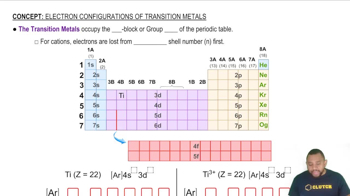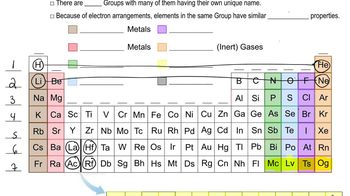An element X reacts with oxygen to form XO2 and with chlorine to form XCl4. XO2 is a white solid that melts at high temperatures (above 1000 °C). Under usual conditions, XCl4 is a colorless liquid with a boiling point of 58 °C. (c) By using a sourcebook such as the CRC Handbook of Chemistry and Physics, try to determine the identity of element X.
(a) Why is calcium generally more reactive than beryllium? (b) Why is calcium generally less reactive than rubidium?
 Verified step by step guidance
Verified step by step guidanceKey Concepts
Reactivity of Metals

Group Trends in the Periodic Table

Comparison of Alkali and Alkaline Earth Metals

Write balanced equations for the following reactions: (a) boron trichloride with water (b) cobalt (II) oxide with nitric acid (d) carbon dioxide with aqueous barium hydroxide.
Write balanced equations for the following reactions: (a) sulfur dioxide with water (b) lithium oxide in water (c) zinc oxide with dilute hydrochloric acid (d) arsenic trioxide with aqueous potassium hydroxide.
Write a balanced equation for the reaction that occurs in each of the following cases: (a) Potassium metal is exposed to an atmosphere of chlorine gas.
Write a balanced equation for the reaction that occurs in each of the following cases: (b) Strontium oxide is added to water. (c) A fresh surface of lithium metal is exposed to oxygen gas. (d) Sodium metal reacts with molten sulfur.
